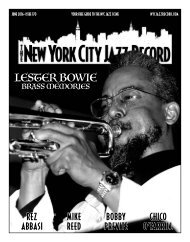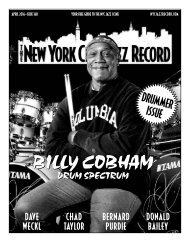Create successful ePaper yourself
Turn your PDF publications into a flip-book with our unique Google optimized e-Paper software.
From The Attic of My Mind<br />
Sam Most (Xanadu-Elemental Music)<br />
by Ken Dryden<br />
Flute players have rarely gotten their due. The late<br />
Sam Most, who was born 85 years ago this month and<br />
passed away in 2013, made it even harder to gain<br />
recognition by his reluctance to promote himself.<br />
Although he played tenor saxophone and occasionally<br />
clarinet, Most was known for his work on flute while<br />
being one of the first to sing as he played. Following a<br />
number of records in the ‘50s, he didn’t make any new<br />
albums under his own name until approached by Don<br />
Schlitten of Xanadu Records in the mid ‘70s.<br />
This 1975 session features a strong supporting<br />
cast: pianist Kenny Barron, bassist George Mraz,<br />
drummer Walter Bolden and percussionist Warren<br />
Smith. The set focuses exclusively on Most’s potent<br />
originals, all excellent blowing vehicles. There are<br />
plenty of fireworks in “What Is, Is”, a fast-paced<br />
opener featuring frequent song quotes, ranging from<br />
the operas Carmen and Pagliacci to jazz and pop<br />
favorites. The sensuous samba “Breath of Love” finds<br />
Most switching to the deeper sound of alto flute,<br />
enriched by spacious, dreamy piano. The spry, upbeat<br />
ballad “You Are Always the One” is a treasure awaiting<br />
discovery, in which flute practically sings a vocal line;<br />
it would be perfect for a vocalist with an added lyric.<br />
“Child of the Forest” is a peppy bossa nova marked by<br />
the leader’s pronounced vibrato and Barron’s<br />
contrasting laidback solo. The bittersweet “One<br />
Forgotten Yesterday”, Most returning to alto flute, is<br />
an emotional ballad played as a duet with Barron in a<br />
strong supportive role. “Keep Moving” is an<br />
unexpected detour into funky blues accented by offcenter<br />
percussion at unpredictable moments, along<br />
with Most’s sung lines as he plays.<br />
Like other CDs in Elemental Music’s Xanadu<br />
reissue series, no expense has been spared in restoring<br />
the Hurricane Sandy-damaged master tapes while<br />
reproducing both the original cover and liner notes, in<br />
addition to new notes and reissue producer Zev<br />
Feldman’s comments. This unjustly neglected<br />
recording will hopefully make flute fans aware of<br />
Most’s contributions.<br />
For more information, visit elemental-music.com<br />
Everybody Digs Michel Doneda<br />
Michel Doneda (Relative Pitch)<br />
by Stuart Broomer<br />
In 1959, Riverside Records released Everybody Digs Bill<br />
Evans, hoping to garner attention for the relatively<br />
unrecognized pianist’s second LP with a cover devoted<br />
to accolades from Miles Davis, Ahmad Jamal and<br />
Cannonball Adderley. Relative Pitch has wittily<br />
adapted the title and design for this solo recital by<br />
Michel Doneda, covering it with quotes from fellow<br />
soprano saxophonists including John Butcher, Sam<br />
Newsome and Dave Liebman, beginning with Evan<br />
Parker’s acrostic “May I commend his excellent legato?<br />
Don’t our needy ears delight anew?” The homage is<br />
fitting, not only as tacit declaration that history does<br />
belong to the experimenters, but to emphasize<br />
Doneda’s stature: a significant voice in Europe for over<br />
30 years, he is relatively unknown in America.<br />
Doneda applies an array of techniques to create a<br />
highly personal vision. The music was recorded at La<br />
Chapelle De La Planques, an ancient stone church in<br />
the town of Tanus in the French Pyrenees, but while<br />
the church undoubtedly contributes to the resonance,<br />
there’s more here than the delay provided by its<br />
Romanesque architecture.<br />
Exploring the nooks and crannies of his horn as<br />
much as those of the church, Doneda creates a labyrinth<br />
of air, breath passing through the horn in various<br />
densities, sometimes creating more than one phantom<br />
pitch, sometimes simply a series of pitch shifts in air.<br />
Pad slaps can signal ominously in what appears to be a<br />
vast echo chamber. At times his sound is flute-like,<br />
achieving the effect of both a monk’s shakuhachi and<br />
the mountain that echoes it. At other times it’s a wind<br />
tunnel and the insects, birds and animals that have<br />
found their way inside. So profound is Doneda’s<br />
involvement in the interior, almost secret, life of his<br />
horn that it comes as a shock when it suddenly blares<br />
forth as a saxophone.<br />
While Doneda brings a host of techniques to his<br />
work, the music is never simply about that. He<br />
simultaneously creates both the perspective of the<br />
explorer and the world through which he moves.<br />
For more information, visit relativepitchrecords.com.<br />
Doneda is at Cornelia Street Café Dec. 20th with Dave<br />
Liebman and Soup & Sound Dec. 21st. See Calendar.<br />
Anomic Aphasia<br />
Han-earl Park Quartet (SLAM)<br />
by Ken Waxman<br />
Guitarist Han-earl Park joins those improvisers who<br />
conceive of a playbook for interactive tactics—his is<br />
called Metis 9. He uses what he calls “focused<br />
complexity” to formulate strategies alongside tenor<br />
and soprano saxophonist Catherine Sikora throughout<br />
Anomic Aphasia, as well as baritone saxophonist/bass<br />
clarinetist Josh Sinton on three tracks and guitarist<br />
Nick Didkovsky on two others.<br />
Like a plucky heroine faced with rebellious robots<br />
in a sci-fi flick, Sikora’s vocally inflected timbres,<br />
especially on the nearly 27½ minute “Monopod”, add<br />
necessary human-sourced harmony to the complex<br />
jangles and static interference from the guitars. As the<br />
guitarists clip staccato whines with ingot-like density<br />
from below the bridges and along the necks, her wistful<br />
soprano saxophone variations preserve the linear form,<br />
eventually making common cause with offbeat folksy<br />
strums from one string player. Hear Sikora’s final<br />
unaccompanied cadenza as potential human triumph<br />
over, or coexistence with, the widening machineproduced<br />
tremolo pumps. A folk-like overlay also<br />
makes its appearance on the concluding “Stopcock”,<br />
although the tenor saxophonist’s concentrated<br />
upwards snarls and magnetic near-string-tearing pops<br />
from guitar strings make the track so atmospheric as to<br />
become almost frightening.<br />
The wailing vigor of Sinton’s bottom-pitched horns<br />
adds to the reeds’ aleatoric strategies on the other three<br />
tracks. Nearly verbalized reed tones are so euphonious<br />
on “Flying Rods” that the subsequent layered lines<br />
nearly move into songbook territory. But Park’s parallel<br />
flanges and hard thumping keeps the results<br />
electronically plugged in as well as pointedly blended.<br />
Sardonically printing a faux questionnaire about<br />
Metis 9 application in the CD booklet shows that Park<br />
champions music over theory. With associates like<br />
Sikora, Didkovsky and Sinton, it appears he can have it<br />
both ways.<br />
For more information, visit slamproductions.net. Park is at<br />
New Revolution Arts Dec. 12th and Delroy’s Cafe and Wine<br />
Bar Dec. 14th. See Calendar.<br />
IN PRINT<br />
Don Alias: Stories of a Legendary Percussionist<br />
Melanie Futorian (s/r)<br />
by Russ Musto<br />
Despite the collaborative nature of jazz, sidemen<br />
rarely receive media coverage commensurate with<br />
the importance of their musical contributions. The<br />
prototypical sideman, percussionist Don Alias<br />
(pronounced a–lie–us) appeared on numerous<br />
record dates and concert performances during his<br />
50-year career, playing drums, congas and bongo<br />
with many of the music’s most important artists.<br />
To honor the memory of Alias, born Christmas<br />
Day 1939 and who passed away suddenly in 2006 at<br />
the age of 66, Melanie Futorian has assembled a<br />
brief but engaging narrative of the life of her<br />
longtime companion, culled from their many<br />
conversations and his own journal entries. The<br />
resultant tome offers an illuminating glimpse not<br />
only into a life of the first-call percussionist, but the<br />
various music worlds of which he was such an<br />
important part.<br />
Alias recounts tales of growing up in a West<br />
Indian household in ‘40s Harlem, first hearing and<br />
then playing AfroCuban music in his multicultural<br />
neighborhood, prior to his first professional gig<br />
playing for Eartha Kitt dance performances,<br />
including one at the 1957 Newport Jazz Festival<br />
with trumpeter Dizzy Gillespie that introduced him<br />
to the jazz world. He tells how a stint with pianist/<br />
vocalist Nina Simone brought him to the attention of<br />
Miles Davis (on whose Bitches Brew date he played)<br />
after which he became the ‘go-to’ percussionist on<br />
the burgeoning fusion scene of the ‘70s.<br />
Anecdotal tales of work with jazz drum masters<br />
Tony Williams and Elvin Jones and popular music<br />
icons Lou Rawls and Trini Lopez testify to the broad<br />
range of his experience. His brutally honest accounts<br />
of working with jazz-rock outfit Blood, Sweat &<br />
Tears and mercurial bassist Jaco Pastorius are most<br />
telling, as is a chapter regarding his period as<br />
songwriter/vocalist Joni Mitchell’s significant other.<br />
There are plenty of tears and laughter along the way,<br />
with remembrances of many tours with saxophonist<br />
Dave Sanborn and others that took him around the<br />
world many times, giving keen insight into the<br />
thrills and travails of life on the road. Futorian’s<br />
photos and Yoko Yamabe’s artwork offer a<br />
compelling visual complement to the revealing<br />
chronicle.<br />
32 DECEMBER 2015 | THE NEW YORK CITY JAZZ RECORD




